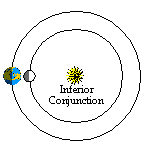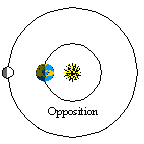(Discovering the Universe, 5th ed., §2-1)
- The time it takes for a planet to complete one orbit is called the orbital period of revolution, often simplified to "orbital period" or just "period".
As with the Moon, we must distinguish between star-relative and sun-relative positions when determining the period:
The sidereal period of a planet refers to the time it takes for the planet to return to the same position with respect to the stars, e.g. from one position on its orbit back to the same position.
The synodic period of a planet refers to the time it takes for the planet to return to the same position with respect to the Sun, e.g. from inferior conjunction to inferior conjunction, or from opposition to opposition.

|
|
 For an inner planet, the sidereal period is shorter than the synodic period, because when the planet returns to its original position the Earth has moved in its orbit, so the planet must travel further to catch up to the Earth.
For an inner planet, the sidereal period is shorter than the synodic period, because when the planet returns to its original position the Earth has moved in its orbit, so the planet must travel further to catch up to the Earth.
In the animation at the right, Venus actually completes two sidereal periods (225 d) before it finally catches up with the Earth after the synodic period (584 d).

- For an outer planet, the sidereal period is (usually)longerthan the synodic period, because when the Earth returns to its original position (one year) the planet has only moved slightly in its orbit, and the Earth doesn't have to travel very far to catch up to the planet.
Mars is an exception to this because it is so close to the Earth; after one year it has already traveled more than half an orbit, so the Earth has to complete two orbits before it can finally catch up to Mars.
No comments:
Post a Comment